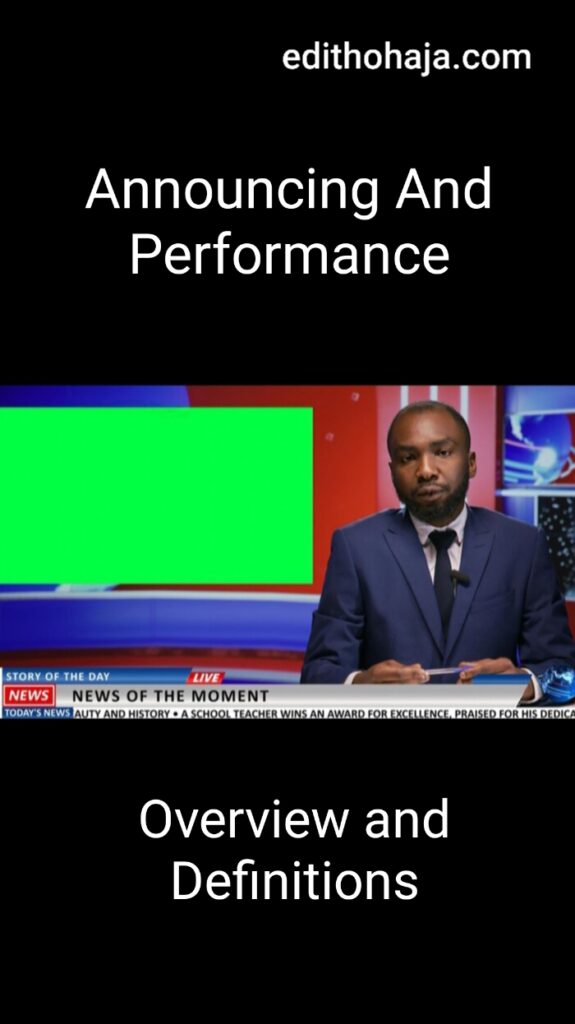Announcing And Performance: Overview and Definitions
Overview
Announcing and Performance, as its name suggests, is a course that is meant to equip aspiring media practitioners with the skills for being on air and communicating effectively. Whether one is working for radio or TV, there are basic abilities required for eliciting interest in an audience, passing across scripted and unscripted messages with clarity, steering the course of programmes masterfully and ensuring continued listenership/viewership.
This course aims at teaching as many of these skills as possible in a hands-on manner. (Note that production, directing and technical areas like set design, lighting, sound control, camera work and editing are not within our purview).
The course will look at how best to carry out continuity announcing, news casting, panel interview moderation, talk show hosting, diverse programmes’ presentation and to a little extent, acting.
Some of the gifts/skills that should come to play are:
• Correct pronunciation and clear enunciation of words (minimising or possibly eliminating mother tongue interferences). For example, the Nsukka way of pronouncing ‘faithful (fatiful);’ use of ‘r’ for ‘l’ and vice versa by some Anambra people; use of ‘g’ sound for ‘y,’ ‘f’ for ‘p,’ ‘kw’ for ‘k;’ pronouncing silent ‘h’ in ‘honour’ and adding ‘h’ to ‘ear.’
• Maintaining the proper cadences of speech to make one’s delivery meaningful (pausing at the appropriate time and not dragging words unnecessarily).
Other gifts/skills include having a good microphone voice, a pleasing appearance (for TV), self confidence, appropriate comportment (serious or lighthearted), a sense of humour and ability to ad lib.
The main objectives of different types of shows should be worked into the discussions to determine the mood and behaviour the announcer/presenter is expected to exhibit.

Definitions
Announcing is a form of communication for public proclamation of messages. The root word of ‘announce’ in Latin ‘annuntiáre’ is derived from the Latin word ‘nuntius’ which means messenger. It is not surprising then that the dictionary meaning of the word announcer in our context is someone who identifies the station, introduces programmes and reads news or other information on TV or radio (Webster’s New World College Dictionary, 2010; Collins Dictionary, 2007).
Acccording to Owuamalam (2007), announcing involves promouncing words and generating meaning that can be shared between a presenter and audience. It is done with a script that must be framed in terms or codes that are understandable to both the announcer and the audience, else the intended goal will not be accomplished.
Owuamalam further says that “announcing brings a station and its audience to a particular programme at a specific time.“ The information contained in announcing directs attention and interest to a particular purpose designed to be satisfied by a programme. For instance, the announcement by a continuity announcer indicating the presentation of a particular address at a particular time on radio or television, particularly at a perilous time like war and disaster, glues the audience to seats close to either radio or television at the promoted time and stated channel.
The word ‘performance’ may simply refer to how well a person or a machine does a piece of work or activity or “the act of entertaining other people” by dancing, singing, acting or playing music. These two definitions are relevant to us because we are concerned with how best to play our roles on air to hold the audience captive to our programmes (couch potatoes). It is not enough to warn the audience, “Don’t touch that dial,” it is our performance that determines if they will do so or not.
Zettl (2003, p. 545) defines the performer with respect to this and related courses as “a person who appears on camera in non-dramatic shows. The performer plays himself or herself and does not assume someone else’s character.”
We shall use the term, ‘presenter’ to distinguish between guests on shows and anchors/moderators.
Presentation is the skilful piloting of a programme to arouse and sustain audience interest. In the words of Owuamalam (2007), “presentation is like the paint which adorns a building.” Members of the public first appraise the painting. If its quality is high, it can make the house look beautiful and lure the beholder to look inside. It means that the builder makes a considerable artistic effort to ensure that any first contact with the structure should be able to attract attention, arouse aesthetic interest and propel a burning desire to see the interior. The exterior must be inviting for anyone to contemplate seeing the various sections inside.
He further likens the presenter to “the icing on the cake and as a receptionist who welcomes listeners/viewers to a broadcast programme and informs them on what to expect from it.”
However, while presentation has a decorative role, it must play that role to enhance attention to the programme and not to distract the public to itself and away from the programme.
In summary, announcing and performance is the most glamorous aspect of broadcasting. It covers the work done by those that the broadcast audience are exposed to, those we see and hear bringing us vital information and piloting programmes on air. Those we are concerned with may not be the most senior staff in the station but the station’s image rests heavily on their work.
You may also like these related posts:


GREAT WORK💓💓💓💓👍
Thank you!
Thanks aunty edith i learnt a lot
Praise God!
This is wonderful 💝
Your works are Inspiring and Educative .
I hope to learn a lot from you.
Thank you…
Masterpiece ❣
Very educative
Thank you ma, I learnt a lot
Wonderful teaching 👏
Ma
Explanation was clear and engaging
Beautiful work ❤️❤️❤️
Well done Ma’am